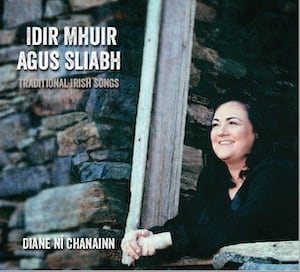 Diane Ní Chanainn – Idir Muir Agus Sliabh
Diane Ní Chanainn – Idir Muir Agus Sliabh
MOC – 24 January 2019
There’s something about Donegal, of that there is no doubt, especially the west. Something happens an hour or so after you cross the border. You feel a gear change. It’s like the body knows automatically how to acclimatise. Things move a little slower here and it shows. It’s substance over style, in everything from the taste of the food to the smell of the turf. Its a pace of life that nurtured a wonderful artistic tradition over centuries, allowing the development of strong, steadfast roots.
From that lineage of artists comes the wonderful Diane Ní Chanainn with at long last, her debut album, titled Idir Muir Agus Sliabh, Between Mountain & Sea.
The opening track Malaidh Chró Luí is just sublime. Diane’s voice is pitch-perfect, there’s no doubt singing is in her blood. But although it has a certain purity, there is a peatiness to it that puts me immediately in mind of a lady who also hails from a county on the West Coast, Delores Keane. And believe me, there aren’t many I would compare lightly to that lady.
This album is loaded with heavyweights in traditional music but, from the off, Diane leads them like a lady on a mission. It’s taken a while for her to reach this point and she’s going to make it count. It would be very easy for an artist to be swept away by the talent on this album, and get lost beneath it. It’s certainly not the case here. In fact, the album is a wonderful tip of the hat to Diane’s homeplace. With the recognisable melody of Gortahork’s Cnoc Na Naomh, she sings as comfortably and familiar as if she were in her own living room. Not even being joined by Altan’s Mairéad Ní Mhaonaigh can phase her. But then again, the tune on which she features, Na Seamróga Feoite, was taught to her many years ago by Diane’s grandfather!
Lough Erne’s Shore is the first song on the album not sung as Gaelige. It’s the first time hearing her voice in English and instinctively begin comparing her to so many other incredible female Irish singers that have come before. Her voice really is beautiful, and can somehow appear rock solid whilst with the same breath convey so much emotion. It’s even more apparent in A Mhaithrin Dhílis when Diane is joined by her daughter Kelly. The song is a conversation bearing close to an argument between mother and daughter. It’s very hard to tell the voices apart at times!
Bainín Mhín an Leá is probably my favourite of the album. According to Diane, it is the sole composition from Jack Néill, a Gortahork native. This is his sole surviving composition, a sad reminder on how many incredible songs and poetry works were possibly not handed down and lost as a result. It tells of the authors love for a protestant girl who lived in the Glen, that was never to be because of their religious differences.
Diane’s daughter Kelly returns and they breathe new life into a song that has truly lasted through the ages, Níl sé ‘na Lá. The band are in full force here, and to name them this time really shows the astounding players that have rallied around Diane to help her on her first musical offering. Donald Shaw, Michael McGoldrick, Neil Martin, Charlie McKerron, Martin Crosssin, Laim Bradley, James Blennerhasset and of course producer and multi-instrumentalist, Manus Lunny. Alone, any one of these people would be most welcome on any record. Together, they’re really spoiling us.
Broom o’ the Cowdenknowes is a new one to me, but it is lovely Scottish love ballad that Diane uses to reflect the connection between Donegal and Scotland that has existed for many, many years. An Draighneán Donn steals seven minutes of your day that you never want back. It’s a snapshot of Ireland of old, a classic sean-nos song where Diane is joined by author and Gaelic historian Lillis Ó Laoire. I haven’t heard the Mountains of Pomeroy in so long and it so good to be able to study up on the story of it, young Reynardine, a half-man, half-fox who’s lovers’ family got in the way of their relationship. These Donegal in-laws are hard to please!
An album of personal songs and tributes to her home, and possibly one of the most beautiful places you could ever visit, is concluded with a very apt song from Tory Island, Toraigh Álainn. The song still sits sad with those have left the most remote inhabited island of Ireland.
Before I finish, I have to say that if you stream this album or download digitally, you will certainly enjoy it, but you will miss out big time without the CD. The inlay book of Idir Muir Agus Sliabh carries with it so much insight from Diane, the stories behind the songs, and portrays the pride the Gaeltacht area of Donegal has its traditions and how important it is they are embraced and passed on.
Diane has fairly put her foot down and made her mark with this debut album. We may have been waiting on it for a while but surely that’s the Donegal way, take your time and do it right. It’s so refreshing to hear so many songs and melodies that we have almost forgotten how much we love, but to hear Diane sing them backed by Manus Lunny and his incredible squad, they breath new life into old traditions, guaranteeing their survival for at least another generation.
Order the album here: https://www.dianecannonmusic.com/new-products


